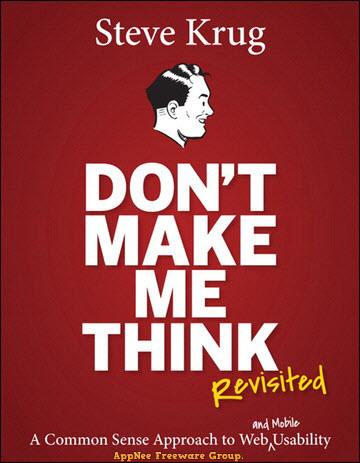
Nowadays, the Internet has become an indispensable part of our lives, technological change has become a dizzying competition, and mobile phones, tablets, computers and even TVs can easily access the Internet. However, the way users access web pages, interact and make choices has not fundamentally changed. That is, users obtain valuable information through the website and find what they need. If the user feels that this process is effortless and does not require thinking, then the website design is considered successful.
Usability design is the most important and difficult task in Web design. A good user experience can attract users to interact with the website. On the contrary, even if the website is designed to be cool and beautiful, it will be unbearable for users. Based on years of experience in the industry, the author of Don't Make Me Think analyzes users' psychology, puts forward many unique perspectives on usage pattern, navigation design, homepage layout, usability testing, etc., and provides a large number of simple and easy-to-implement usability design recommendations. This book is suitable for technical personnel engaged in Web design and development, especially for website/webpage designers who are worried about how to retain visitors.
Don't Make Me Think uses pithy, humorous writing, and rich illustrations and diagrams to describe key points, examples, and insights about website usability. The main idea is to create designs where users don't need to think too much about how the interface works - so that it not only solves problems but also make it easy to use. In the book, the author sets out some basic principles about interface usability and shares them with professionals working in the field, making this book one of the most important resources recommended by UX/UI designers.
This book, first released in 2000, is an unquestionable classic and remains timeless today. Because this book discusses the usability in website design, whose content has not become obsolete as technology evolves. After all, user experience is not only about technology and craftsmanship, it is also a science about people. Today, more than 10 years after this book was first published, user experience has become its own field, but the techniques and principles mentioned in this book are still very useful for beginners and even inspiring for experienced designers. Don't Make Me Think proves one thing to us: technology will change with the times, but common sense will never go out of date.

Table Of Contents
- Chapter 1. Don't make me think!
- Chapter 2. How we really use the Web
- Chapter 3. Billboard Design 101
- Chapter 4. Animal, Vegetable, or Mineral?
- Chapter 5. Omit needless words
- Chapter 6. Street signs and Breadcrumbs
- Chapter 7. The Big Bang Theory of Web Design
- Chapter 8. "The Farmer and the Cowman Should Be Friends"
- Chapter 9. Usability testing on 10 cents a day
- Chapter 10. Mobile: It's not just a city in Alabama anymore
- Chapter 11. Usability as common courtesy
- Chapter 12. Accessibility and you
- Chapter 13. Guide for the perplexed
Book Example Codes
- Files mentioned in this book (and a few extras)
Download URLs
| Format | Download | Size |
| Don't Make Me Think, Second Edition | ||
| reserved | 10.3 MB | |
| Don't Make Me Think, Revisited | ||
 |
8.49 MB | |